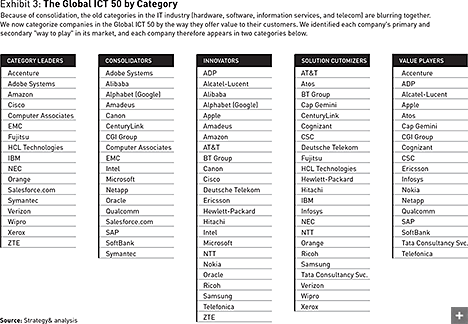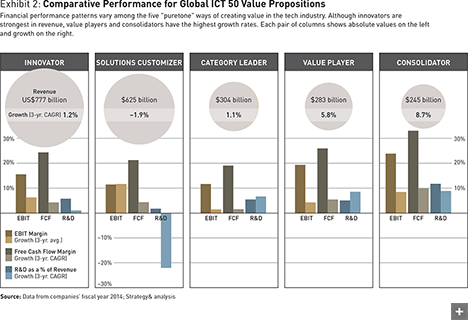The New Game of Global Tech
As distinctions dissolve among the hardware, software, services, and telecom sectors, companies are changing how they compete.
What’s going on in the information and communications technology (ICT) industry? Companies that used to thrive with clearly defined product portfolios are entering one another’s businesses. Erstwhile hardware companies such as Hewlett-Packard (HP) and Xerox have moved into software services. Software companies such as Microsoft, Amazon, and HCL Technologies make smartphones. Companies that used to offshore computer services, such as WiPro, are moving back onshore and competing through the cloud. Telecom companies are building out their Internet of Things connections so trucking companies can monitor fleets and consumers can link up smart homes. In all these categories, profitability is more elusive than it used to be, and no one can be certain about the future — or even the continued existence — of any given sector.
In short, the easily defined and sharply delineated product and service categories of the past no longer exist. The blurring of these categories, which has been taking place steadily since 2000, has now reached critical mass: ICT companies consistently horn in on one another’s markets and customer base. You can meaningfully differentiate among these technology providers — picking the winners and losers of the future, and aligning your own purchases of B2B technology products and services accordingly — only by understanding the strategic value proposition of every company. If an ICT company distinguishes itself as an innovator, that will lead to a different end result than if it stands apart as a platform provider or value provider. Moreover, success in the high-tech industry no longer goes automatically to those with first-mover advantage, or even to those with a superior platform; it goes to companies with the most distinctive value proposition, and the ability to deliver on it.
At Strategy&, PwC’s strategy consulting business, we have seen these effects accelerate through four years of work on our annual Global ICT 50 study, an analysis of the strategic potential of technology companies based on their financial performance, portfolio strength, geographic footprint, and innovation and branding. Indeed, the convergence was so pronounced in this year’s study that the old categories into which we divided the 50 largest ICT companies — hardware and infrastructure, software and Internet, IT services, and telecommunications — no longer describe the industry and how it is changing. (See “The 50 Largest ICT Companies.”)
The 50 Largest ICT Companies
Each year, Strategy&, PwC’s strategy consulting business, compiles a list of the 50 largest publicly traded companies in the ICT sector, ranked by a formula combining four measures: financial performance, portfolio strength, geographic footprint, and innovation and branding. Together, these criteria determine the degree to which these companies influence the enterprise market for digitization-related products and services. The most recent study, compiled with 2015 data, provides a clear picture of the most powerful companies in this industry, especially for B2B hardware, software, and services (see Exhibit 1). Several noteworthy findings:
• Eight of the top 10 companies from 2014 remained in the top 10 of the 2015 rankings, indicating some stability in the industry at its highest levels. The rest of the rankings, however, differed considerably from the year before.
• HP, ranked before its decision to split into two separate companies, moved up three spots to number six, driven by its improving financial results.
• EMC, ranked before its acquisition by Dell in early 2016, moved up to the ninth spot from number 13, thanks largely to the greater breadth of its product portfolio.
• Intel jumped all the way from number 24 to number 12, thanks primarily to the increased strength of its product portfolio as it shifts from being a pure hardware-oriented company to a company with an integrated mix of hardware and software.
• No telecommunications operators or regional IT service providers are in the top 15, an indication of these companies’ continued strategic challenges and the constraints imposed by their physical and geographic boundaries.
The supply side is also changing. Technologies and services that once produced considerable value, such as operating systems, connectivity, and computing infrastructure, are now commoditized. M&A activity continues to grow; companies rely on deals to expand their product and service portfolios, to buy market share, and to divest nonessential lines of business. ICT companies are also innovating at a frantic pace through in-house R&D, corporate venture capital, and other investments. According to the 2016 Global Innovation 1000 study, Strategy&’s annual analysis of R&D investment at the largest public corporations, five of the top 10 spenders on innovation in 2015 were ICT companies: Samsung, Amazon, Alphabet (Google), Intel, and Microsoft. Apple, Cisco, and Oracle were also in the top 20. (See “Software-as-a-Catalyst,” by Barry Jaruzelski, Volker Staack, and Aritomo Shinozaki.) The industry has also become more innately competitive; the major ICT companies are restructuring their operating models, optimizing their production and service delivery capabilities, and tapping into the global workforce.The forces behind convergence are evident. The ongoing digitization of virtually every industry has led enterprises to put forth an entirely new set of demands for technological products and services. Cloud computing, the consumerization of IT through smartphones and tablets, increased mobility, big data analytics, the Internet of Things, and digital fabrication have radically altered the mix of technologies that companies need to conduct business. More than 68 percent of corporate investment in information technologies was made outside the traditional IT department in 2015, according to PwC’s Digital IQ survey. This represents a dramatic rise from 47 percent a year earlier. B2B customers place greater value on asset-light suppliers with pay-on-demand, software-as-a-service (SaaS) models, rather than the large, major-investment enterprise IT providers of the past.
Given these pressures, it’s no wonder that companies in the sector are moving beyond their traditional product lineups and markets. Today, they are developing distinctive value propositions that transcend the old categories. Those that succeed will gain a competitive advantage that’s sorely needed in this amorphous business environment. To win, however, every company must find an identity based on its strengths: the things it can do that no one else can, buttressed by new capabilities that it can build or buy effectively. With some companies, such as Apple, Amazon, and Microsoft, it’s clear to everyone what those capabilities are. Others in the industry are just learning how to compete this way.
Five Recipes for Success
Because the companies in the ICT sector no longer compete within the old sector boundaries, they must now define themselves another way: through the manner in which they offer value to their customers. There are many methods of doing so, but five value propositions are particularly prevalent in this industry. All five are viable ways of reaching customers, especially enterprise customers, with technological solutions. Each of the five has a business model and economic profile distinct from the others and distinct from the overall ICT 50 formula. Each has its own approach to growth, profitability, scale, and investment. The archetypes are detailed here, along with the indicators used to identify them.
1. Category leaders. These companies focus on building a dominant position in a relatively narrow product or service category. They use that position to shape and influence the supply markets and sales and delivery channels in that category. A key indicator of this strategy is the positioning of a company’s products and services. We used assessments of market categories from the industry research firms Gartner Group (its “Magic Quadrant”) and Forrester Research (its “WAVE” analysis) to determine that 17 companies among the Global ICT 50 are category leaders. (We assigned each company in the list both a primary and secondary alignment according to their way of doing business. Our tallies here reflect these dual assignments. See Exhibit 3.)
Among the companies that follow this strategy closely are Accenture, IBM, Xerox, Fujitsu, and Computer Associates (CA). Each has focused its activities in recent years to establish a high level of control over a relatively narrow subsector. For example, Accenture has concentrated on large-scale process reengineering and solution integration, investing in customer interfaces related to those fields. Xerox has shed products and services that don’t fit its main business of printing and imaging technology.
2. Consolidators. These companies lead their category through repeated acquisitions. They roll up other companies to provide consumers with access to a platform of products and services, or simply to offer a product lineup that could be assembled no other way. M&A activity is, of course, a leading indicator of this strategy. Based on a combination of total deal volume and value of acquisitions from 2010 to 2015, relative to the company’s revenue, we found 18 companies using this strategy.
Many companies that are active consolidators — including Salesforce.com, Intel, SAP, Alibaba, and Qualcomm — are known for their aggressive and effective M&A. SAP, for example, has consolidated a portfolio of enterprise SaaS solutions that complement its original ERP core, including procurement (Ariba), corporate travel (Concur), HR (SuccessFactors), work management (Fieldglass), and e-commerce (Hybris). Salesforce.com has expanded its core CRM on-demand services portfolio into new categories, buying software companies specializing in marketing (ExactTarget, Radian6, and Buddy Media, now Salesforce Marketing Cloud), data analytics (Jigsaw, now Data.com), customer service (Assistly, now Desk.com), and workforce performance (Rypple, now Work.com).
3. Innovators. These companies continually develop and introduce new and creative products or services to the market. Investment in R&D is the primary indicator of this strategy. On the basis of their rankings in this year’s Strategy& Global Innovation 1000 study, 24 companies qualify — the most numerous of the five value propositions, yet surprisingly few considering that all technology development involves innovation.
Many of the best-known technology companies, including Apple, Samsung, Google, Amazon, and Microsoft, have succeeded through this value proposition. Apple provides a good example of how such companies consistently develop notable new products and services. In partnership with IBM, it is moving into the enterprise domain, producing business-to-business apps that offer the same seamless, user-friendly mobile experience for which its consumer products are known. Apple is also fostering innovation in the wellness and home markets with its HealthKit and HomeKit services, which enable third-party developers to develop apps for its products. Amazon, Google, and Microsoft, meanwhile, are among the world’s top innovators in cloud services and related analytics.
4. Solutions customizers. Companies following this strategy make use of insight and market intelligence to offer tailored products or services that address customers’ specific needs. The leading indicator that a company is employing this strategy is its revenue from activities such as solutions consulting, outsourcing, and implementation services relative to total revenue. We found 23 solutions customizers in the Global ICT 50.
Companies closely correlated with this strategy include Cap Gemini, Computer Sciences Corporation (CSC), Tata Consultancy Services, Infosys, and HCL Technologies. The list may expand in future years as other companies in the industry become more proficient at customizing, configuring, and operating IT services. In the meantime, companies such as CSC distinguish themselves by configuring a range of ICT disciplines in packages (including systems integration, operations, and end-user support), often tailored to particular types of enterprise clients. HCL is noteworthy for its distinctive engineering and “enterprise functions as a service” offerings, grounded in capabilities built through years of back-office R&D.
5. Value players. These companies seek enterprise business by lowering the costs of competitive services. We identified 18 of these companies in the top 50, on the basis of revenue from commoditized products and services driven by economies of scale (such as the operation of asset-heavy infrastructure or the mass manufacturing of computing components and electronics) relative to total revenue, and the extent of production and service delivery in low-labor-cost geographies. Many of these companies are information services providers: Tata Consultancy Services, Infosys, Cognizant, and Accenture are among them. They often rely on low-cost offshore labor combined with highly standardized and industrialized delivery models.
The five value propositions can be thought of as “puretones”: basic, generic ways of creating value. In practice, most ICT companies combine two or more of them into their own distinctive identity. For example, Qualcomm, in addition to being a value player and consolidator, is also recognized as an innovator. In mobile telecommunications and other sophisticated technology, the company makes much of its income from licensing that technology to other enterprises. This sometimes includes proving out the design by manufacturing prototypes, often at relatively low cost.
Successful companies do not choose a value proposition lightly; their choice is closely tied to their identity. Any winning value proposition must be supported by a distinctive capabilities system: a combination of processes, tools, knowledge, skills, and organization that no other company has. (See Strategy That Works: How Winning Companies Close the Strategy-to-Execution Gap, by Paul Leinwand and Cesare Mainardi [Harvard Business Review Press, 2016].)
For example, Amazon has developed distinctive capabilities that reinforce its value proposition, which combines being an innovator and a category leader. Its capabilities include elegant, seamless online retail interface design; highly innovative back-end supply chain management; rapid and effective online merchandising (identifying and promoting fast-selling products effectively); and increasingly effective customer relationship management. It can apply these capabilities to many new offerings, such as its pacesetting cloud venture, Amazon Web Services, while remaining true to its identity.
Although all the value propositions can be viable, an analysis of financial results during a three-year period (2012–15) demonstrates the superiority of innovation as a path to success in the ICT industry (see Exhibit 2). Companies with an innovator value proposition have captured the largest share of the overall ICT market, even though their growth rates have slowed over the past three years. For example, Apple, Google, and Samsung have all seen their growth slow, but continue to lead their industries in market share.
The consolidators’ share of the market is much smaller than that of the innovators; however, their margins are significantly higher and, in many cases, growing rapidly. They also spend more on R&D as a percentage of revenues, suggesting that the search for innovation through inorganic growth, not market share or pure financial engineering, drives the high level of M&A activity in the sector. The financial results for value players have largely held steady since 2013 — no surprise, given that they typically compete through their advantageous cost structure, not through innovation. That strategy, we expect, will enable them to continue to gain market share and enjoy healthy margins.
The revenues of the solutions customizers are shrinking, though they have been increasing their margins and free cash flow. This suggests that as they mature, they are trying to optimize their costs, in part by spending little on R&D compared with companies following the other strategies; in fact, solutions customizers’ R&D spending has actually decreased over the past three years.
With weak revenue growth and little margin improvement, category leaders appear to be maintaining a holding pattern. Their significant investment in R&D as a percentage of revenues has not always paid off, at least in the short term. They often seem to be relying on income from their cash cow businesses, a strategy that may not be sustainable.
Which Strategies Work?
Can ICT companies use these insights about strategy and performance to improve their prospects? Can B2B customers use them to evaluate which vendor platforms will endure, and thus be worth adopting? The insights are revealing, but decision makers should proceed cautiously. Although some of the value propositions appear to be doing better than others in the rapidly changing ICT environment, none of them guarantees success. What does seem to correlate with success most consistently is coherence: having a clear, single value proposition, aligned with a group of mutually reinforcing capabilities that fit with most or all of your products and services. Coherence allows you to execute your strategy better than anybody else.
Success in the high-tech industry goes not to those with first-mover advantage, but to those with the most distinctive value proposition.
The innovators’ unsurpassed coherence has allowed them to dominate the ICT market in terms of revenues, total profit, and R&D capacity. We’ve already noted that Amazon and Apple have used their highly focused value proposition — Amazon’s identity as a lean and analytics-driven provider of utility computing, e-commerce, and content distribution; Apple’s identity as a purveyor of superior design and digital user experience — to enter a variety of sectors and shape their future accordingly. Microsoft and Google are moving toward a similar level of focus on a clear value proposition. Microsoft, for example, based its identity for years on its Windows and Office application product lines, which led to a temporary slump in performance as well as relevance. More recently, it has been shifting its value proposition to focus on enterprise effectiveness through its cloud offerings, accommodating multiple operating systems and platforms. Microsoft’s 2016 purchase of Linked-In will reinforce this approach, enabling new enterprise-oriented businesses that fit with a broad range of hardware, software, and services.
The innovator value proposition is visibly successful, and many companies seek to join the innovators’ ranks. Because the category is led by such a formidable group of competitors, however, it may not be feasible for many companies to make this leap — especially in B2B products and services.
Solutions customizers command a considerable amount of heft in the ICT space, but lately seem to have hit a growth ceiling. They have been “jack of all trades” juggernauts that have built highly diversified product and service portfolios over the years to meet the demands of their customers. Now they need to focus on a single value proposition, with the capabilities to match — and their highly complex organization and operating model makes this challenging. We expect solutions customizers to streamline their portfolio while cutting costs strategically and, in successful cases, reinvesting for growth in some narrowly defined subsectors.
Consolidators have generated a lot of momentum over the past few years, but M&A activity tends to be cyclical, and megadeals such as the Dell–EMC combination may become less frequent. One certainty: Successful deals will be ever more closely aligned to the companies’ value propositions. Companies such as SAP and Salesforce.com are using deals this way to build cloud-based portfolios and then work through their post-integration execution “homework” with the same degree of discipline.
Value players have long enjoyed profitable growth. Paradoxically, however, their very success is having economic repercussions that may put the entire strategy in question. As value players seek new pockets of growth, they increasingly need to scale up resources in mature economies, the primary market for their services for years to come. That will mean taking on high-cost labor to build sales forces and bringing new staff on board as part of an outsourcing arrangement, which in turn dilutes their previous core advantage of using low-cost skilled labor, predominantly in India. There may always be another aspiring low-labor-cost geography to which they can turn. But the Indian model, oriented to 125 million English speakers and a highly effective technology talent education engine, will be challenging to replicate at scale in any other emerging economy.
Given these challenges, the value players must solidify and evolve several key capabilities if they are to thrive. They must maintain and strengthen the integrity of their lean delivery practices, even as their customer base and range of services grow more diverse and complex. They must forge a productive global culture where onshore and offshore management philosophies, values, and behavior meet. And they must reduce costs in all parts of their global delivery footprint, devoting some of the capital saved to investing in lean, highly scaled, automated service delivery offerings, in order to maintain their factor-cost and execution advantages.
Then there are the category leaders. Long blessed with strong identities based on their powerful position in specific product or service markets, they have shaped their respective industries by developing strong — but expensive — innovation, marketing, and customer service capabilities. Now their growth and profitability are slowing down, suggesting that they need to rethink their company identity, particularly their value proposition and distinctive capabilities. They must also shake off any elements of their culture that have ossified or become bureaucratic, if they are to make the strategic changes necessary to succeed.
Despite the diversity of their value propositions, all of these companies can learn from one another. To be sure, it would be counterproductive for a committed category leader to try to boost profitability by becoming a value player. At the same time, however, that category leader might take a page from the value player playbook to develop ways to deliver its products and services more efficiently.
If you are a technology company leader — whether or not your company is in the Global ICT 50 — your next major strategic move may well be to look more closely at the way you go to market. Scrutinize your current value proposition and the capabilities you bring to bear. Then form a considered opinion: How well will they serve you in this rapidly consolidating industry? Chances are, among your existing capabilities are several that should be called out and developed further, so that you can forge an identity no other tech company offers.
Reprint No. 16408
Author profiles:
- Olaf Acker is a thought leader in digital services for Strategy&, PwC’s strategy consulting business. Based in Frankfurt, he is a partner with PwC Germany and leads PwC Digital Services for Europe, the Middle East, and Africa. His focus is technology and digital transformation.
- Florian Groene is an advisor to executives in the communications, media, and high-tech sectors for Strategy&. Based in New York, he is a principal with PwC US. He helps companies develop customer experience and build operating and technology models for the digital age.
- Germar Schroeder is an advisor to executives in the telecommunications industry for Strategy&. He is a partner with PwC Germany based in Frankfurt. He focuses on product development, go-to-market, and operating model design, specifically for the cloud.
- Also contributing to this article were Strategy& researcher Mikula Jung, a senior associate with PwC Germany, and s+b contributing editor Edward H. Baker.







